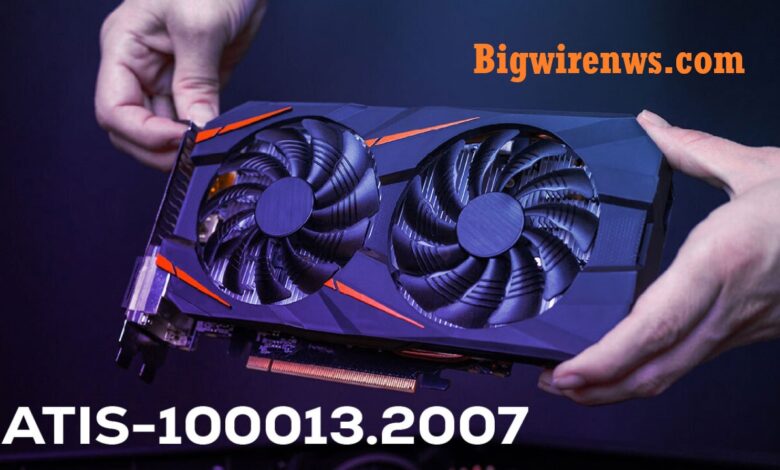Understanding ATIS-100013.2007: A Comprehensive Guide

Introduction to ATIS-100013.2007
ATIS-100013.2007 represents a significant milestone in the realm of telecommunications and GPU technology. The Telecommunications Industry Solutions Alliance (ATIS) created the product; this standard outlines the requirements and guidelines for Automatic Speech Recognition (ASR) systems and advanced GPU networks. The introduction of ATIS-100013.2007 in 2007 marked a leap forward in integrating ASR into telecommunications and enhancing the performance of GPU networks.
Historical Context and Significance
The technological landscape of 2007 was transformative, with innovations such as the first iPhone revolutionizing mobile communication and social media platforms altering online interactions. Within this context, ATIS-100013.2007 emerged as a crucial development, driving advancements in computational power and GPU technology. The standard not only addressed the need for high-performance computing but also facilitated the seamless integration of ASR technology in telecommunications, paving the way for improved user experiences and operational efficiency.
Key Features of ATIS-100013.2007
High-Performance Graphics Processing
ATIS-100013.2007 excels in delivering high-performance graphics processing, which is essential for applications requiring intensive computational power, such as gaming, multimedia production, and virtual simulations.
Advanced Networking Integration
A standout feature of ATIS-100013.2007 is its advanced networking capabilities, enabling efficient communication between GPUs. This integration supports collaborative computing environments, enhancing data exchange and processing across interconnected systems.
Scalability and Adaptability
The standard’s scalability allows it to adapt to various workloads, making it suitable for both small-scale projects and large-scale enterprise applications. This flexibility is crucial for dynamic and demanding computational tasks.
Real-Time Responsiveness
Designed to handle real-time applications, ATIS-100013.2007 ensures responsiveness, which is vital for virtual and augmented reality applications, as well as other time-sensitive computing tasks.
Parallel Processing Capability
Leveraging parallel processing, ATIS-100013.2007 accelerates complex computations by executing multiple tasks simultaneously. This feature is particularly beneficial for data-intensive workloads such as scientific simulations and artificial intelligence projects.
Security and Privacy Guidelines
Security is a paramount concern in telecommunications. ATIS-100013.2007 includes comprehensive guidelines to protect user data and ensure privacy, covering encryption methods and access control mechanisms to comply with relevant regulations.
Applications of ATIS-100013.2007
Virtual and Augmented Reality
The real-time responsiveness of ATIS-100013.2007 makes it ideal for VR and AR applications, enhancing immersive gaming experiences and virtual simulations.
High-Performance Computing (HPC) Workloads
In the realm of HPC, ATIS-100013.2007 efficiently handles data-intensive workloads, contributing to faster execution of complex computations essential for scientific research and financial modeling.
Data Analytics and Machine Learning
The GPU network’s high-performance computing capabilities expedite data processing and enhance the training of machine learning models, facilitating quicker insights and decision-making.
Distributed Processing Environments
Implementing ATIS-100013.2007: Best Practices
System Integration
Successful implementation of ATIS-100013.2007 requires seamless integration with existing telecommunications systems. This involves configuring interfaces, ensuring compatibility with other technologies, and conducting extensive testing.
Training and Calibration
ASR systems must be trained and calibrated to achieve optimal performance. This involves using large datasets for training, fine-tuning algorithms, and continuously updating the system to improve accuracy and efficiency.
User Feedback and Continuous Improvement
Obtaining and evaluating user input is essential for refining ASR systems. Continuous improvement mechanisms should be implemented to enhance system performance and user experience over time.
Challenges and Considerations
While ATIS-100013.2007 offers numerous benefits, there are challenges to consider. The cost of implementing such advanced technology can be high, and compatibility issues with existing systems may arise. Additionally, the learning curve for utilizing ATIS-100013.2007 to its full potential can be steep, requiring specialized knowledge and expertise .
The Future of ATIS-100013.2007 in Telecommunications
Emerging Technologies
The future of ATIS-100013.2007 looks promising with advancements in artificial intelligence and machine learning. These technologies will enhance ASR capabilities, enabling more natural and intuitive interactions.
Expanding Applications
As ASR technology evolves, its applications in telecommunications will expand. Future possibilities include:
- More sophisticated virtual assistants.
- Advanced voice biometrics for security.
- Enhanced support for multilingual communication.
Conclusion
ATIS-100013.2007 is a pivotal standard that has significantly contributed to the advancement of telecommunications and GPU technology. By adhering to this standard, telecommunications providers can ensure high performance, reliability, and security in their systems. As technology continues to evolve, ATIS-100013.2007 will be vital in determining the course of telecommunications, making interactions more seamless and efficient for users worldwide.
Also Read: The Power of iLikeCix: Revolutionizing the Way We Explore the Internet




